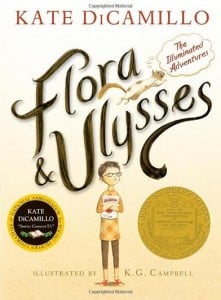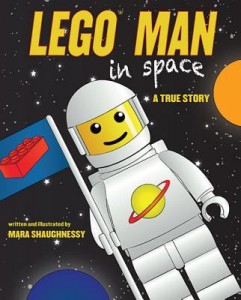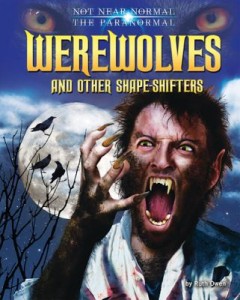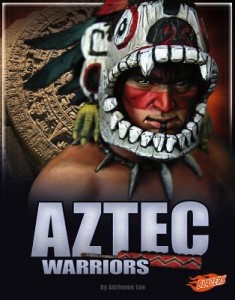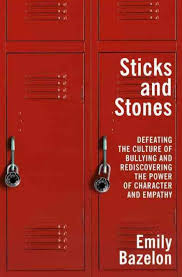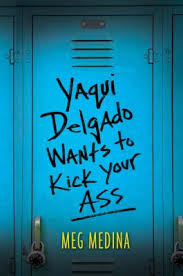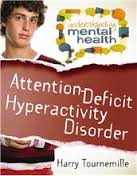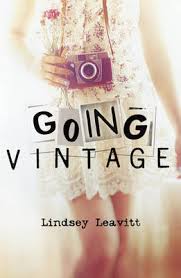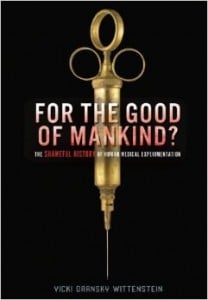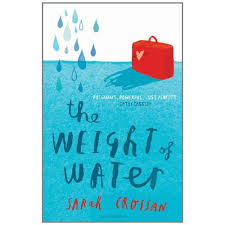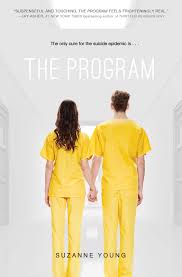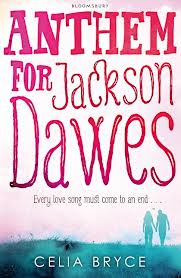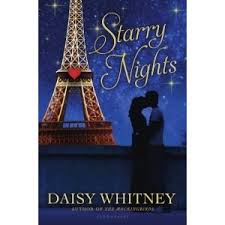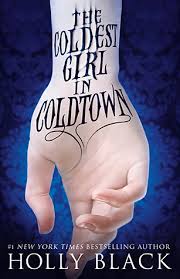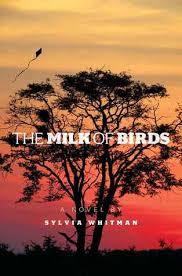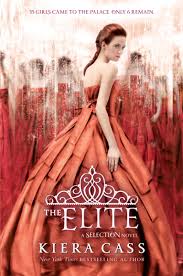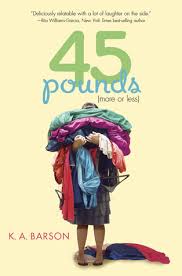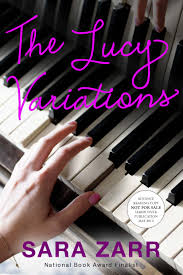DiCamillo, Kate. Flora & Ulysses. Somerville, MA: Candlewick, 2013. 978-0763660406. 240p. $17.99. Gr. 3+
Kate DiCamillo has done it again: written a can’t-put-it down, funny, and heartwarming tale of love and acceptance, and again she won the Newbery Medal. Flora is an eccentric, 10-year-old “natural born cynic.” Her mom is a romance novelist who disdains Flora’s love of comic books, specifically Incandesto! which has taught Flora just about anything she could possibly ever need to know about life. This wealth of knowledge comes in handy when her neighbor’s super-powered vacuum sucks up and almost kills a squirrel. Said squirrel – who Flora dubs Ulysses – survives the brush with death and becomes a superhero, able to fly, type poetry, and communicate with nods and facial expressions. But most importantly he loves Flora dearly and their adventures change everyone around them. This book is sweet, quirky, and laugh-out-loud funny. While those as young as 8 will enjoy it, DiCamillo’s nuanced characters and situations will appeal to all ages through adults. Highly recommended!
Fiction, Magical Realism Kathie Jackson, Plymouth Meeting Friends School
Monthly Archives: February 2014
LEGO Man in Space: A True Story
Shaughnessy, Mara. LEGO Man in Space: A True Story. New York: Sky Pony Press, 2013. 978-1-62087-544-5. 32 p. $14.95. Gr. K-3.
This book tells the true story of two children, Mat and Asad, who launched a LEGO figure into space. The LEGO man traveled 80,000 feet into the air in a spaceship made of a weather balloon and a homemade parachute, and the boys included a cell phone with GPS so that they could track the spaceship when it landed. The title is “narrated” by the LEGO man who made the trip, blurring the lines between strict fiction and nonfiction, but lending a fun gimmick to attract young readers. The illustrations are colorful and help show the different steps in LEGO man’s journey.
This would be a great book to preview with younger kids—show them the YouTube video and there will surely be tons of LEGO fans ready to read!
621 Lindsey Long, Nye Elementary School
Werewolves and Other Shape-Shifters
Owen, Ruth. Werewolves and Other Shape-Shifters (Not Near Normal: The Paranormal). New York: Bearport Publishing, 2013. 978-1-61772-695-8. 32 p. $20.00. Gr. 3-6.
This series is sure to be popular with the older elementary crowd. It includes Aliens and Other Visitors, Ghosts and Other Spirits of the Dead, Half-Human Monsters and Other Fiends, Vampires and Other Bloodsuckers, Werewolves and Other Shape-Shifters, and Zombies and Other Walking Dead.
Werewolves and Other Shape-Shifters explores werewolf folklore from different countries, such as France’s Beast of Gévaudan and Myanmar’s Taw creature, and combines it with interesting stories and pop culture references (like werewolf Jacob Black from Twilight). There’s also a two-page spread showing werewolves and other shape-shifters around the world.
The spooky, colorful illustrations will definitely thrill your students. I know this one will fly off the shelf!
This title includes a table of contents, glossary, index, bibliography, and “Read More” section.
398.24 Lindsey Long, Nye Elementary School
Aztec Warriors
Lee, Adrienne. Aztec Warriors (Legendary Warriors series). North Mankato: Capstone Press, 2014. 978-1-4765-3117-5. 32 p. $25.99. Gr. 3-6.
This interesting, attractive hi/lo series includes Aztec Warriors, Gladiators, Knights, Ninja, Samurai, and Vikings.
Aztec Warriors contains a few sentences of information with lots of illustrations on each two-page spread. The facts are stated succinctly and glossary words are included in sidebars at the bottom of the page, making this book a good choice for a reluctant reader. It’s certainly interesting—did you know that Aztec warriors were either Eagle or Jaguar warriors, wearing suits of animal skins or cloth covered with feathers?
This title includes a table of contents, glossary, index, “Read More” section, and internet sites. One note: this series is a reworking of Capstone’s “Warriors of History” series, so I wouldn’t recommend these books if your library owns that set.
972 Lindsey Long, Nye Elementary School
Challenges Facing Teens – Nonfiction
Bazelon, Emily. Sticks and Stones: Defeating the Culture of Bullying and Rediscovering the Power of Character and Empathy. New York: Random House, 2013. 386 p. 978-0812992809 $27.00 Gr. 10 and up.
From Bazelon’s articles about bullying as a senior editor of Slate magazine comes this full-length, researched and readable book about the social side of the lives of teenagers. After watching a growing national preoccupation with bullying (some of it rightfully presented, some of it falsely reactionary) Bazelon steps in to define what bullying is and what it is not. She contends that teenagers often need to jockey for place in relationships, much of this they view as normal “drama”, and adults should view it as necessary growth to navigate work and school, now and later. When this reasonable social aggression becomes skewed in favor of one side (all the power to one, all of the fear to another), it’s bullying. Bazelon focuses on three teenagers: middle-schooler Monique, whose tormentors’ tactics led her to change schools and find relief in family and community support; Jacob, whose flamboyantly gay attitude makes him a regular mark for attacks, and whose parents successfully sue his school for violation of his civil rights; and Flannery, who Bazelon asserts is wrongfully blamed by the courts for the suicide of depressive, bullied classmate Phoebe Prince. She also maintains that although technology has changed the landscape for teens and adults, bullying hasn’t increased; only the tactics have changed, leaving long trails for perpetrators and victims. It is we who have over-reacted. She identifies unsuccessful zero-tolerance-style policies which she maintains do not make much sense in light of teenagers’ immature worldviews. In the most useful section, she profiles successful programs used in schools to promote character and empathy in students. Unfortunately, in “supporting” the victims, her own biases are clear; in attempting to enlighten with a new view, she may well oversimplify: Monique’s school was blind; Jacob’s school was homophobic; and Flannery was the victim of a witch-hunt. Monique, Jacob, or Flannery have no need to question their actions or tactics; everyone else was at fault. Rarely are such “all or nothing” attitudes realistic (a point she herself makes, then falls prey to). She ends with FAQs about Bullying, Resources for Readers, notes, and glossary. Recommended where awareness of the current bullying debate is desired.
302: Bullying Psychology and Prevention Melissa Scott, Shenango High School
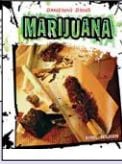
Dangerous Drugs (series). New York: Cavendish Square Publishing, LLC, 2014. 64 p. $23.95 Gr. 5-9.
Benjamin, Daniel. Marijuana. 978-160870-8253.
Benjamin, Daniel. Steroids. 978-160870-8260.
Burlingame, Jeff. Alcohol. 978-160870-8222.
Burlingame, Jeff. Crystal Meth. 978-160870-8239.
Peterson, Christine. Inhalants. 978-160870-8246.
Peterson, Christine. Vicodin and Oxycontin. 978-160870-8277.
Each of the six books in this new series covers the risks of using the drug. Each book is divided into four or five chapters covering description, risks/side effects, personal stories, and how to get help. The format is inviting, colorful, readable, and short enough not to intimidate. The personal stories told in the words of the drug users (shared in Marijuana and Steroids) and the before and after photos of meth users (shared in Crystal Meth), are the most likely to grab readers’ attention for the “real” side of the drug use. Many of the graphics are helpful (diagrams of the physical aspects of the drug’s toll, photos of physical effects of meth, lists of side effects, warning signs of a friend’s use), a few of the photos include styles that are clearly dated and could be a turn-off. Due to limited space and a focus on prevention, Marijuana does not cover legalization. These books are a good match for the intended middle-grade audience. Glossary, Index, and Resource List.
362.29: Drugs Melissa Scott, Shenango High School
Yaqui Delgado Wants to…
Medina, Meg. Yaqui Delgado Wants to Kick Your Ass. Somerville, MA: Candlewick, 2013. 978-0763658595. 272 p. $16.99. Gr. 9-12.
The title and opening line of this gritty realistic fiction will easily encourage students to pick up the novel, but the engrossing story will not make it easy to put it down. Author Meg Medina has written a gripping account of one girl’s struggle with bullying in an urban high school. Piddy Sanchez is in her tenth grade year at a new school after her mother finally realized her dream to move to a nicer (less-rundown) apartment. Raised by a single mother, Piddy knows very little about her father, a fact which comes up frequently in conversations with her mother, but the focus of the story is Piddy’s experience at her new school. She is quickly blindsided by a classmate yelling at her, “Yaqui Delgado wants to kick your ass!” She does not, however, know who Yaqui is or why she has become the target of Yaqui’s ire. Darlene, one nosy student who seems to know everything, tells Piddy that Yaqui and some of the other Latino girls think that Piddy, who is Latino but does not “look” the part, sways her hips while she walks to attract all of the boys in school, Yaqui’s boyfriend included. Piddy quickly becomes the target of numerous attacks by Yaqui, which range from lunchroom encounters to physical attacks. Piddy chooses not to confide in her mother. Instead, she begins missing school, trying to get her mother’s best friend Lila to lie about her whereabouts and spending days with a boy from her former neighborhood. The themes of bullying, identity, acceptance, and growing up are all illustrated clearly and realistically through Piddy and her experiences. This novel will have you wondering how many students have experiences like Piddy’s, and wondering how we can make school a safer place for all students.
Realistic Lindsey Myers, Peters Township High School
I was completely engrossed while reading Yaqui Delgado Wants to Kick your Ass. I do not usually gravitate towards urban fiction, but in this case I was glad that I did. I recently spent time in various classrooms book talking about books with a bullying theme, and this title was high on my list to share with students. Even though I am in a suburban school district, many students will still identify with Piddy and her struggles throughout the novel. Medina has a simple writing style that evokes the voice of a young teen unable to tell her mother exactly what is going on at school.
With that being said, our Book Club selection for February will be the recent debut title Reconstructing Amelia by Kimberly McCreight, which I chose over Yaqui Delgado simply because I believe that my students will relate more to the characters and the style of bullying being highlighted in Reconstructing Amelia. Even though the main characters in each novel are fairly similar (both live in New York City, both are being raised by single mothers who work long hours), the setting and cultural backgrounds could not be more different. Piddy lives in a low-income area and goes to a rough public school, while Amelia lives in a lovely brownstone and attends an expensive prep school. I enjoyed each title and the themes reflected in both, but as my goal is to elicit discussions on bullying in our own school, Reconstructing Amelia will be a better springboard for a dialogue on issues occurring in our student body. I hope to have a few of our more dedicated readers also read Yaqui Delgado in order to have a discussion comparing and contrasting the two stories and the types of bullying highlighted in each one. For now, I hope that my book talks have encouraged enough students to check out either title and learn more about how we can address bullying in all schools.
Informational Texts – February 2014
Understanding Mental Health (series of 6) New York: Crabtree Publishing Company, 2013, 2014.
Tournemille, Harry. Attention Deficit Hyperactivity Disorder. 978-0778700692 48 p. $23.95
Iorizzo, Carrie. Anxiety and Phobias. 978-0778700821 48 p. $23.95
Two books from the six-book series focusing on mental health problems. The books open with, and often include, personal experiences with the disorders, defining and giving causes for these issues. Various therapies and drugs are discussed in sections on diagnosis and treatment. Importantly, how to deal with stigma, managing behavior, and even making friends, are all covered in a short space. Both books end with a “Coping Toolbox” of tips to try and self-care tips, offering ideas like keeping a journal; meditation; distraction; or visualization. Fine, helpful additions for middle school and above, these books are informative without being threatening. Glossary, index, other web resources included. Also part of the series: Autism Spectrum Disorder; Depression and Other Mood Disorders; Fetal Alcohol Spectrum Disorder; and Schizophrenia and Psychotic Disorders.
616; Mental Health Melissa Scott, Shenango High School
Essential Library of Social Change (series of 6), ABDO Publishing Company, 2013.
Anderson, Jennifer Jolene. Women’s Rights Movement. Minneapolis, MN: ABDO Publishing Company, 2014. 112 p. 978-1617838897 $23.95
Eboch, Chris. Green Movement. Minneapolis, MN: ABDO Publishing Company, 2014. 112 p. 978-1617838880 $23.95
Two books from the six-book series presenting the stories behind the rise of social movements. Both books detail the movements from earliest beginnings to today. The unfortunate “retro” color scheme of yellows and greens over black and white photos will do little to attract readers; and dismal covers lack any overview of the movement or indication of each books individual contents, when students often need a description to be drawn to the topic. Readers who do venture into the books will find the comprehensive and interesting stories behind these movements. Women’s Rights Movement chronologically details major proponents Elizabeth Cady Stanton, Susan B. Anthony, Lucretia Mott, Sojourner Truth, and others, with the Temperance Movement, the Nineteenth Amendment, Title IX and more. Green Movement discusses environmental issues like population growth, climate change, Love Canal, and environmentalists John Muir, Theodore Roosevelt, Rachel Carson, on to present-day conservationists. Timeline, Essential Facts, Glossary, Index, Resources (updated at abdopublishing.com) and extensive Source Notes. Also part of the series: Animal Rights Movement; Civil Rights Movement; Disability Rights Movement; and Gay Rights Movement.
Social Sciences Melissa Scott, Shenango HS
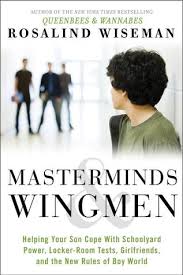
Wiseman, Rosalind. Masterminds and Wingmen: Helping Our Boys Cope with Schoolyard Power, Locker-Room Tests, Girlfriends, and the New Rules of Boy World. New York: Harmony Books, 2013. 378 p. 978-0307986658 $25.00
Wiseman, author of Queen Bees and Wannabes which spurred national thinking about girls’ inner lives and relationships (and the movie Mean Girls), now turns her attention to the usually overlooked world of boys’ social problems. Beginning with sobering statistics on the state of boys, she declares, “we often make the mistake of believing that if a boy doesn’t come to us with problems, then he doesn’t have them.” Not so, she declares, sharing insights from over 200 boys nationwide, of all socio-economic classes, who opened up to her about expectations, letdowns, insecurities, and misunderstood behavior. “The reality,” she states, “is that most boys’ days are filled with many of the same social challenges that girls face, and what they learn from those experiences matters…. boys’ problems can look deceptively simple and we can’t interpret the signs when they’re calling out to use for help.” Wiseman goes on to identify those signs, from the slacker attitude, to lying, parenting styles that further alienate, and a host of problems and technologies that create new, troublesome worlds our boys desire to conquer, but need guidance to do so. According to Wiseman, they will listen to adults who listen to them without hypocrisy and without lecture, willing to show them how to be real men. Wiseman means her lengthy book to be read as needed, focusing on the area of need. Throughout, she refers to SEAL, the strategy she teaches boys for dealing with conflict: STOP and SET it up (think about the best way to confront); EXPLAIN (the problem needs to be stated); AFFIRM and ACKNOWLEDGE (the right for both sides to be treated with dignity); and LOCK (in or out, decide how or whether to continue the relationship). Judging from the boys’ responses and a ton of “aha, so that’s why they do that” from readers here, the book has hit some powerful thinking, namely that our boys are not simple, and they need us. Highly recommended for parents and anyone who works with boys and teenagers.
649; Psychology; Teenage Boys Melissa Scott, Shenango High School
Going Vintage in a Digital Age
Leavitt, Lindsey. Going Vintage. New York: Bloomsbury, 2013. 978-1599907871. 320 p. $16.99. Gr. 9-12.
Cyber bullying is currently a hot topic in educational circles, and much literature has been written on the topic. Leavitt takes a lighter approach to cyber bullying in her newest novel, Going Vintage. The main character, Mallory, thinks that she has the perfect boyfriend, and they spend most of their time together. One day, however, Mallory logs on to Jeremy’s computer and discovers that Jeremy is cheating on her with an online girlfriend as part of a virtual world called “Authentic Life.” Mallory feels betrayed and decides to give up on boys and technology. While cleaning out her grandmother’s house with her antique-dealer father, she locates a list that her grandmother wrote of her goals for 1962. Among the items on the list are: finding a steady boyfriend, sewing a dress for homecoming, cooking a family meal, running for pep club secretary, and doing something dangerous. Mallory makes it her goal to complete her grandmother’s list. She soon realizes that it is harder than she thought to give up on technology, even though creating a pep club means that she will be spending more time with Oliver, Jeremy’s cute and fun cousin. The novel provides insightful commentary on our current teenage population’s obsession with their phones. Mallory feels isolated from her friends at times, but also discovers pleasure in simple things like phone calls with Oliver. The novel seeks a balance between scaring students and making them think about their actions, and does an excellent job of achieving this goal.
Realistic Lindsey Myers, Peters Township High School
As I am sure many teachers and adults in general have noticed, students these days are obsessed with technology, mainly their Smartphones. Students are constantly connected to their phones and are either texting, Snapchating, listening to music, or Tweeting.
This book would be an excellent companion piece to a lesson on the pervasiveness of technology and our dependence on, and sometime addiction to, our personal devices. Currently, I am working on a unit on Digital Citizenship with Honors English 9 students. Their final project is to design a lesson on some aspect of digital citizenship for a chosen grade from Kindergarten through fifth grade. Students began with researching the topic, and then were given a lesson plan outline and suggestions on completing their lesson. I am amazed and excited about the ideas and discussion that has resulted from these lessons. I wish that we had more time (don’t all librarians?!) so that I could share passages from this book along with articles on the uses and abuses of social media. Our next part of the lesson will involve having students read recent articles on social media, and using chapters of this book would be an excellent strategy for incorporating novels into discussions of social issues and technology. I am certain that many students can relate to Mallory’s reliance on her cell phone and the feeling of being left out when not connected to this device, but also feeling as though technology is overtaking their lives. I am going to suggest it as a title for our book club in the spring and hopefully work with the English teachers in various grades to use parts of the book to introduce the concepts of digital citizenship.
Warm Books for Cold February Days (and nights) – New in YA
Wittenstein, Vicki Oransky. For the Good of Mankind? The Shameful History of Human Medical Experimentation. Minneapolis, MN: Twenty-First Century Books, 2014. 96 p. 978-1467706599. $27.00 Gr. 7 and up.
A short but powerful book, illuminating unethical medical practices justified as research from earliest times through today. Wittenstein excels at opening chapters with tales of sobering experiments with such horror that the reader is left to question the truthfulness of any medical personnel. Although medical research codes of ethics govern researchers’ behavior today, “the rules in place are only as effective as those who practice them” (96). The book covers a variety of experiments, from sterilization to the well-known Tuskegee studies, from Dr. Walter Reed’s ‘informed consent’ experiments eventually leading to a yellow fever vaccine, to uninformed patients, at times slaves or prisoners, being injected with radioactive elements. Wittenstein devotes one chapter to the Nazi experiments and resultant Nuremburg trials. She shows how many years of suffering (and at times, success) were needed before medical ethics were established that protected a patient’s human rights before medical or wartime needs. Questions abound: Is any experiment justified for national security? How do researchers balance safe studies with need for financial support? Is compensation enough to ensure justice, or does it limit the volunteer pool? Is the human genome map, with potential to reveal personal information about disease, a practical help or an emotional hindrance for individuals or family planning? An excellent beginning source on biomedical ethics. Critical Analysis, Source Notes, Bibliography, Further Information, Glossary, and educational resources online at lernersource.com.
174: Medical Ethics Melissa Scott, Shenango High School
Crossan, Sarah. The Weight of Water. New York, Bloomsbury, 2013. 9781599909677. 211p. $16.99. Gr. 7-10.
Kasienka is a twelve year-old girl living in Gdansk, Poland. Her father (Tata) has abandoned her mother and her, so they live with her grandmother (Babcia). When they receive a check from Tata with a clear postmark from Stansted, Great Britain, that is all the encouragement her mother needs. She takes Kasienka, and they immigrate to Great Britain carrying along their meager belongings in one suitcase and a laundry bag. Kasienka is enrolled in school, but they put her in with eleven year olds because she can’t read English. When she is finally moved to the seventh grade, she is befriended by Clair, the resident mean girl. At first Clair is nice to her, but as time goes by Clair becomes increasingly hostile towards “Kassie.” Kassie becomes the victim of Clair’s bullying tactics, including a haircut in a student assembly. Kasienka is a very good swimmer, and she swims at the local pool when she is not in school or helping Mama look for Tata by going door-to-door. Kanoro is their neighbor, and he befriends both Mama and Kasienka, and he gives Kasienka an address for her Tata. Kanoro advises Kasienka to go alone, and she does. She finds he has a new girlfriend and another child, but he wants to see her, he wants to have her over for dinner, he even signs a permission slip for Kasienka to go to compete in a swim meet that her Mama won’t sign. Kasienka doesn’t know how to resolve this situation, so she decides to tell Mama. Mama is engulfed by sadness and takes her anger and frustration out Kasienka. She isn’t violent; she is seething with anger, and ignores Kasienka. Kasienka gives her some time to come to terms with the fact that Tata loves someone else, and eventually Mama becomes more like her old self. Kasienka likes William who is a diver, and she draws some strength from this relationship, because he believes she can help herself. Another breakthrough comes when Lily enters the school and Kassie volunteers to be her partner, Lily smiles at her and that is the beginning of a real friendship for Kassie. Clair is powerless against this new empowered Kassie. This is a novel that I believe if students give it a chance they may see things from a different perspective. The immigrant angle may interest some, but they will be confused by some of the references in the book such as July 7 (a reference to the 2005 bombings in London’s transport system); something a teenager may scarcely remember. Glossary included.
Novel in Verse Kathryn Gilbride, North Pocono High and Middle Schools
Young, Suzanne. The Program. New York: Simon Pulse, 2013. 978-1-44244-580-2. 416 p. $16.99. Gr. 9 and up.
Young’s first volume in this new dystopian series will appeal to fans of Lauren Oliver’s Delirium and Ally Condie’s Matched series. Sloan Barstow is a 17-year-old living in a world that is experiencing an epidemic, teenage suicide. To combat the problem one town in Oregon has set up a six week program established to help teens with their depression and reintroduce them to society. Sloan and her friends try to keep their feelings a secret to stay off the radar and avoid The Program. Teens going into The Program come back different with no memories of their prior life. The only person Sloan can truly be real with is Jamie, her boyfriend but soon even he can not help her hide her feelings. When Jamie is taken away for treatment in The Program Sloan’s emotions begin to show and she is also sent away to The Program. The story is told in three parts from Sloan’s view, before The Program, during The Program, and after The Program. Sloan retains one memory of life before The {rogram and it is this memory that sets up the series for future books. The sequel, The Treatment, is set to be published April 29th. A rich story that is sure to be a hit for fans of dystopian stories.
Dystopian, Science Fiction Robin Burns, Salisbury High School
Bryce, Celia. Anthem for Jackson Dawes. New York: Bloomsbury, 2013. 978-1-59990-975-2. 240 p. $16.99. Gr.7 and up.
Megan Bright is only thirteen when she arrives at the children’s ward at her local London hospital for cancer treatment. As one of the oldest patients she finds herself not only battling a brain tumor but also to not been seen as a child. Jackson Dawes a teenager also battling cancer quickly becomes her confident and her rock as they both progress through their treatments. Megan is like any other person facing a major illness asking why some people get sick while others never seem to suffer. The death of Jackson causes Megan to spiral out of control and learn to lean on family and friends for support. Although the novel has many British slang terms readers should be able to relate to the universal story. Fans of John Green’s Fault in Our Stars will find similarities with the storyline and content but will enjoy the story for its own unique examination of a life.
Realistic Robin Burns, Salisbury High School
Whitney, Daisy. Starry Nights. New York: Bloomsbury, 2013. 978-1-61963-133-5 288 p. $17.99. Gr. 7 and up.
Julien is a Parisian teenager who has free run over the Musee d’Orsay in Paris which his mother runs. Late one night Julien believes he sees dancers leaving Degas paintings and peaches falling out of a Cezanne painting. Soon paintings at other museums are mysteriously burning, flooding, and fading off of the canvas. This story weaves together art history and ancient mythology into a modern day love story. Clio, a muse,leaves a Renoir portrait she has been trapped in for centuries to roam the museum at night with Julien. Together Julien and Clio must find out what is happening to the paintings before all the masterpieces are ruined. Whitney does a great job of telling a love story and providing detailed information about famous artworks and the painters throughout the novel.
Fantasy (Mythology) Robin Burns, Salisbury High School
Black, Holly. The Coldest Girl in Coldtown. New York: Little, Brown and Company, 2013. 419 p. $19.00. Gr 9-12.
Tana is a pretty average teenager– except in her world, humans and vampires reside in quarantined cities called Coldtowns. One night after a wild party, Tana wakes in the bathtub to find the rest of the house littered with corpses. Soon she stumbles upon her ex-boyfriend Aidan– freshly bitten and on the edge of infection– as well as the handsome and alluring vampire Gavriel. A heart-pounding series of events lead her to the nearest Coldtown, on the hunt for the most destructive vampire of all time in order to save Aidan, Gavriel and herself, as well as her closest friends and family. Black’s writing is impeccable as she weaves Tana into a fierce, powerful teenager ultimately in charge of her own destiny. She would leave Twilight’s Bella shaking in her boots. Quite graphic and gory at times, this one is best recommended for older teens.
Horror, Paranormal Vicki Schwoebel, Friends’ Central School
King, A.S. Reality Boy. New York: Little, Brown Books for Young Readers, 2013. 978-0316222709. 353p. $18.00. Gr. 9-12.
Ever wonder just how much is not real on a reality show? If you ever stopped to think about how much is not true, and what happens to the children involved, then this book is for you. Over 10 years have gone by since Gerald became known as The Crapper since he left his crap in a variety of places around the house to show his anger at his dysfunctional family who is starring in a reality show called Network Nanny. Gerald is now 16 going on 17 and still cannot get rid of the rage surrounding his family and life and the ever present nickname. This story explores his hopeful journey to normalcy as he begins a relationship with Hannah an equally troubled teen with her own issues. All of the students who read this book really liked it and although the sexual content and language was a bit explicit and strong, all thought that there was nothing that students haven’t read or heard about before. One student liked how both teens were from totally different backgrounds and were still so messed up and confused with both teens hoping that one day they would be able to leave their troubles behind. Another student commented on how the parents and adults in this story were so single-focused and irresponsible that their actions caused even more problems for themselves and the children. The heart of this book is all about family dynamics and no matter whether it is out there for all the world to see or kept hidden, its lasting effects are still very much felt by all those involved.
Realistic Marian Kohan, Erie School District
Whitman, Sylvia. The Milk of Birds. New York: Atheneum, 2013. 978-1-4424-4682-3. 363p. $16.99. Gr. 8 and up.
If you walk, you can dance; if you can talk, you can sing. Sweet sayings like this are sprinkled throughout The Milk of Birds by Sylvia Whitman, a story of two fourteen year old girls, one a Sudanese refugee and the other an American teen in Virginia, told through letters. As the story progresses readers learn of the troubles and hardships that each teen endures, from destroyed villages to divorcing parents. Through it all both girls stay strong and serve as positive role models through their long-distance friendship. Although it can be predictable at times, readers are sure to be motivated to do something positive for others.
Realistic Laura Ward, Fox Chapel Area HS
Cass, Kiera. The Elite (Selection Book 2). New York: HarperTeen, 2013. 978-0-06-205996-3. 323p. $17.99. Gr. 8 and up.
American Singer swore she was only entering this love contest to help her family financially. But now she’s made it into the Elite, the top six in Illea’s search for the next princess and her worst fear is coming true…she’s starting to have feelings for Prince Maxon. All of a sudden she’s sorting out her new emotions and battling the old now that her ex has been assigned as a palace guard. Will her self-doubt and quick temper get in the way of her being with the one she loves and becoming Princess America?
Dystopian; Romance Laura Ward, Fox Chapel Area HS
Barson, K.A. 45 Pounds (More or Less). New York: Viking, 2013. 978-0-670-78482-0. 264p. $16.99. Gr. 7-10.
When Ann Galardi’s aunt asks to her to be a bridesmaid, she thinks it’s the perfect time to shed 45 pounds. She’s quiet to spend $80 on a gimmicky diet program, but will the pounds disappear as easily? Ann has two weeks of frozen food that tastes like the cardboard it came in, an exercise DVD, and the hopes of becoming the fun and popular skinny girl she’s always dreamed of. Barson does a great job tapping into the mind of an overnight teen giving readers a glimpse of the insecurity, paranoia, and heartache many teens face on a daily basis when dealing with their body image.
Realistic Laura Ward, Fox Chapel Area HS
The Lucy Variations
Zarr, Sara. The Lucy Variations. New York: Little, Brown, and Co., 2013. 978-0-316-20501-6. 304p. $18.00. Gr. 8 and up.
Lucy Beck-Moreau, a child piano prodigy, had it all: fame, fortune, and a piano career on the world’s stage that most can only dream about, but that was before her sixteenth birthday and the death of her grandmother. Now, eight months after leaving the stage in Prague and quitting the piano forever, at least according to her grandfather, Lucy begins to re-examine her choices and the pressure talent places on a person as her ten-year-old, brother Gus (also a child prodigy) steps into Lucy’s previous life. Through her relationship with Gus, her best friend Reyna, and Will, Gus’s piano teacher, Lucy begins to question her choices, the familial pressure placed on her and Gus because of their talent, and the path in which her life can go: a path without music or a path through it. Sarah Zarr once again creates a realistic teenage character whose movements between questions, uncertainty, spontaneity, and rebellion ring true no matter one’s musical ability (the novel is sectioned with musical terminology). Lucy’s struggles of finding herself will ring true for most readers.
Realistic; Coming-of-Age Erin Parkinson, Lincoln JSHS, Ellwood City
Although The Lucy Variations was a starred title in almost every review journal and was highly praised, I did not love it. I understand Zarr’s point in the story and recognize that she wrote another magnificent novel, but I struggled through many parts of it. First of all, I struggled with Lucy’s relationships with both her English teacher, Mr. Charles, and Will, Gus’s piano teacher. Please do not get me wrong: Zarr’s representations of these relationships is spot on and very well developed; my issue is that they are just uncomfortable to read because of Lucy’s age. Zarr depicts Lucy as very mature, so her “feelings” make sense, but she is still sixteen, so there is the uncomfortable aspect of the story. I felt this more with Will because of the development between Lucy and Will than I did with Mr. Charles. Mr. Charles is a teacher crush; Will is much more because he shows interest in Lucy and her talent in a way that her family does not; they feel that Lucy needs to progress with her talent and use it as both means and end. Will sees the “fun” in the piano and Lucy’s need for enjoyment through her talent. I would have liked to have seen Will push this aspect of there “relationship” instead of the uncomfortable moments on Lucy calling him, meeting him for coffee, and attending a party at his home with a much older crowd. I know Lucy is not a normal sixteen-year-old, but her relationship with Will should have been. I think a more teacher-mentor-student relationship would have made the novel more impactful than the awkwardness and uncomfortable moments shared by Will and Lucy. I did really enjoy Will’s influence on bringing Lucy back to piano; Zarr did an excellent job with this aspect and should have continued this portion. Even though I did not love The Lucy Diaries, I did enjoy it very much as are my students. They are able to see Lucy as a mirror of themselves (even though most of them aren’t very musical) and that is the most important aspect of YA literature.

